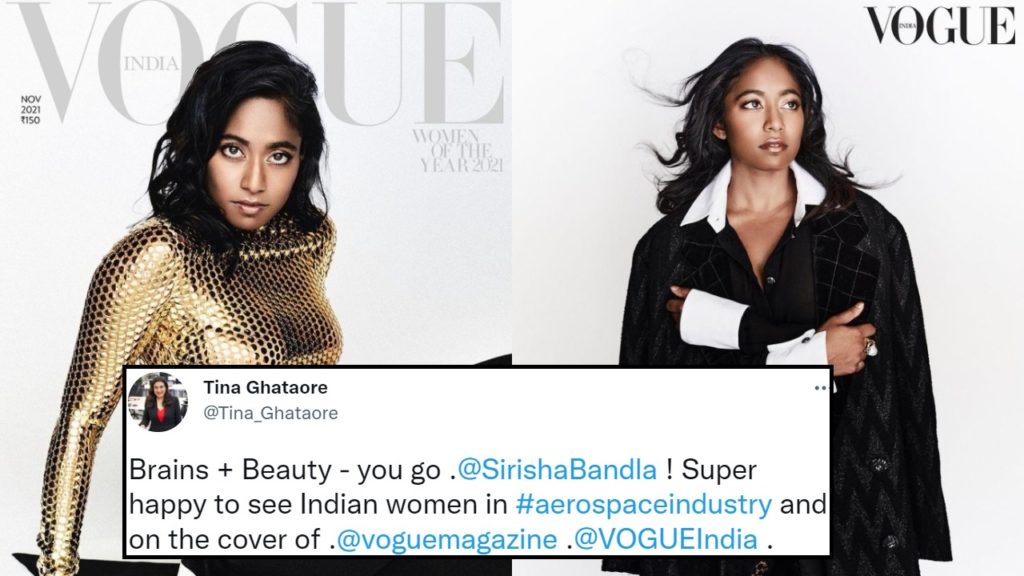For the longest time, fashion magazine covers were reserved for models and actors with toned bodies, chiseled jawlines, perfect hair, and fair skin. But in recent years, we have been seeing women achievers such as KK Shailaja, Kamala Harris, and Malala Yousafzai, gracefully appearing on magazine covers, reminding us of how far we have come.
Recently, the OG fashion magazine, Vogue, celebrated another such woman achiever – Andhra-born Sirisha Bandla, an aeronautical engineer who became the 2nd India-born woman and the 3rd Indian-American woman to fly to space, reports Hindustan Times.
Speaking to Vogue, Sirisha opened up about experiencing a lack of suitable role models while growing up and how representation matters. Since aeronautics is a male-dominated field, she said she had “adrenaline seeking white men” for role models.
“What’s incredible is the number of messages I’ve got, especially from young women in India. It’s interesting how much of a mental barrier there is for people when they see somebody they can’t relate to, doing what they want. So for women to see themselves in me—either from a connection of where we grew up, how we look, or our culture—is powerful.”
Here is a little bit about Sirisha Bandla:
She was born in Chirala, a city in Andhra Pradesh, and is now 34-years-old. In 1991, Sirisha’s father, a microbiologist, moved to the US from Guntur to pursue his PhD. His family moved along as well. Sirisha went on to pursue engineering in Purdue University, Indiana. One of her role models while growing up was Kalpana Chawla.
“I saw in her an exceptional Indian woman doing something I wanted to do. It made it so much more real.”
She was 15-years-old when Kalpana Chawla died as NASA’s space shuttle exploded while re-entering the atmosphere.
In July 2021, Sirisha was among the five passengers on the Unity 22 spaceflight that took off for the 1.5-hour mission above New Mexico from the Spaceport America launch facility at 10:40 AM.
“I followed Kalpana’s career through the internet, but it’s hard when you don’t have someone to talk to. You start questioning yourself: ‘Is it all in my head?’ Those are the kind of microaggressions and hurdles that women of colour face. That kind of representation reduces barriers for women very young. It shows them that it’s something they can do,” she said.
Here’s how people reacted to the incident:
In case you needed a reminder, this remains a @SirishaBandla stan account. https://t.co/DN4eED00Yc
— Kevin Zagorski (@KevZag) November 5, 2021
Virgin Galactic astronaut @SirishaBandla featured in Vogue India:
"For women to see themselves in me—either from a connection of where we grew up, how we look, or our culture—is powerful.”https://t.co/4RapqIbp0g
— Michael Sheetz (@thesheetztweetz) November 5, 2021
Big congrats to @SirishaBandla , Virgin Galactic all-around superstar, commercial astronaut and now one of Vogue India's Women of the Year!! https://t.co/74tbRYogrN
— George Whitesides (@gtwhitesides) November 5, 2021
seeing @SirishaBandla on the cover of Vogue this morning was such a good start to the day 🤩 pic.twitter.com/J2i2CenO2C
— michelle | 書宇 (@MichTheMartian) November 5, 2021
.@MattFellowship Team Member @SirishaBandla on @VOGUEIndia's "Women of the Year" cover! 🌟 "She is our new role model and remains optimistic about the diversity of people who will soon access space as we find ourselves on the cusp of commercial travel." https://t.co/de0YbU4yCq
— Matthew Isakowitz Fellowship (@mattfellowship) November 5, 2021
Brains + Beauty – you go .@SirishaBandla ! Super happy to see Indian women in #aerospaceindustry and on the cover of .@voguemagazine .@VOGUEIndia . Inspiration to the millions of young girls everywhere. We have more to do! https://t.co/baxFLHJKJ7
— Tina Ghataore (@Tina_Ghataore) November 6, 2021
I don't have all the words to express my enthusiasm for seeing amazing POC women, friends, in my field helping to open doors and inspire others, especially beyond our space bubble. Space is cross-sectoral and @SirishaBandla is using her voice to open space to everyone. #space https://t.co/Pa8i5bnMI6
— Stephanie W (@AsianSpaceLady) November 5, 2021
Times are changing! 🙂
